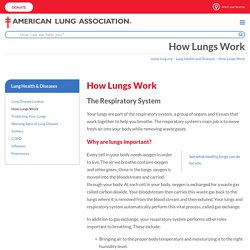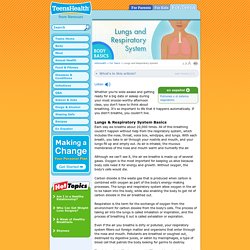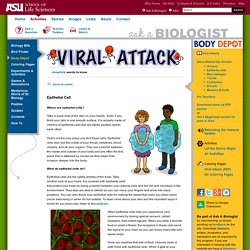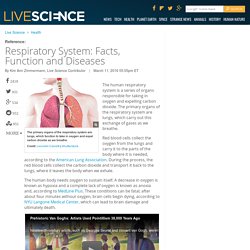

American Lung Association. The Respiratory System Your lungs are part of the respiratory system, a group of organs and tissues that work together to help you breathe.

The respiratory system's main job is to move fresh air into your body while removing waste gases. Why are lungs important? Every cell in your body needs oxygen in order to live. The air we breathe contains oxygen and other gases. In addition to gas exchange, your respiratory system performs other roles important to breathing. Bringing air to the proper body temperature and moisturizing it to the right humidity level.Protecting your body from harmful substances. The Parts of the Respiratory System and How They Work Airways SINUSES are hollow spaces in the bones of your head above and below your eyes that are connected to your nose by small openings. Lungs and Blood Vessels Your right lung is divided into three LOBES, or sections. Muscles and Bones Your DIAPHRAGM is the strong wall of muscle that separates your chest cavity from the abdominal cavity.
Respiratory Cells. Lungs and Respiratory System. Listen What They Do The two openings of the airway (the nasal cavity and the mouth) meet at the pharynx (pronounced: FAR-inks), or throat, at the back of the nose and mouth.

The pharynx is part of the digestive system as well as the respiratory system because it carries both food and air. At the bottom of the pharynx, the pathway for both food and air divides in two. One passageway is for food (the esophagus, pronounced: ih-SAH-fuh-gus, which leads to the stomach) and the other for air. The larynx (pronounced: LAR-inks), or voice box, is the uppermost part of the air-only passage. At its bottom end, the trachea divides into left and right air tubes called bronchi (pronounced: BRAHN-kye), which connect to the lungs. With each inhalation, air fills a large portion of the millions of alveoli. ASU - Ask A Biologist. Back to comic Where are epithelial cells?

Take a quick look at the skin on your hands. Even if you think your skin is one smooth surface, it is actually made of millions of epithelial cells that are tightly packed next to each other. That’s not the only place you find these cells. Epithelial cells also line the inside of your throat, intestines, blood vessels, and all your organs. What do epithelial cells do? Epithelial cells are the safety shields of the body.
Stained epithelial cells by Page Baluch Other epithelial cells help you experience your environment by having special sensors, called receptors, that collect signals. Once you swallow that bite of food, it travels down a path lined with epithelial cells. What do epithelial cells look like? If you take a close look at epithelial cells using a microscope, you will see them tightly packed together. Epithelial cells come in different shapes depending on where in the body they're found. Back to comic. Untitled. Respiratory System: Facts, Function and Diseases. The human respiratory system is a series of organs responsible for taking in oxygen and expelling carbon dioxide.

The primary organs of the respiratory system are lungs, which carry out this exchange of gases as we breathe. Red blood cells collect the oxygen from the lungs and carry it to the parts of the body where it is needed, according to the American Lung Association. During the process, the red blood cells collect the carbon dioxide and transport it back to the lungs, where it leaves the body when we exhale. The human body needs oxygen to sustain itself. A decrease in oxygen is known as hypoxia and a complete lack of oxygen is known as anoxia and, according to MedLine Plus. Prehistoric Van Goghs: Artists Used Pointillism 38,000 Years Ago Nineteenth-century artists, such as Georges Seurat and Vincent van Gogh, weren't the first to use pointillism, according to a discovery of 38,000-year-old decorated limestone tablets in France. Untitled.